
Scaling Up speakers talk bioeconomy successes, gaps in Canada
November 14, 2023
By
Maria Church
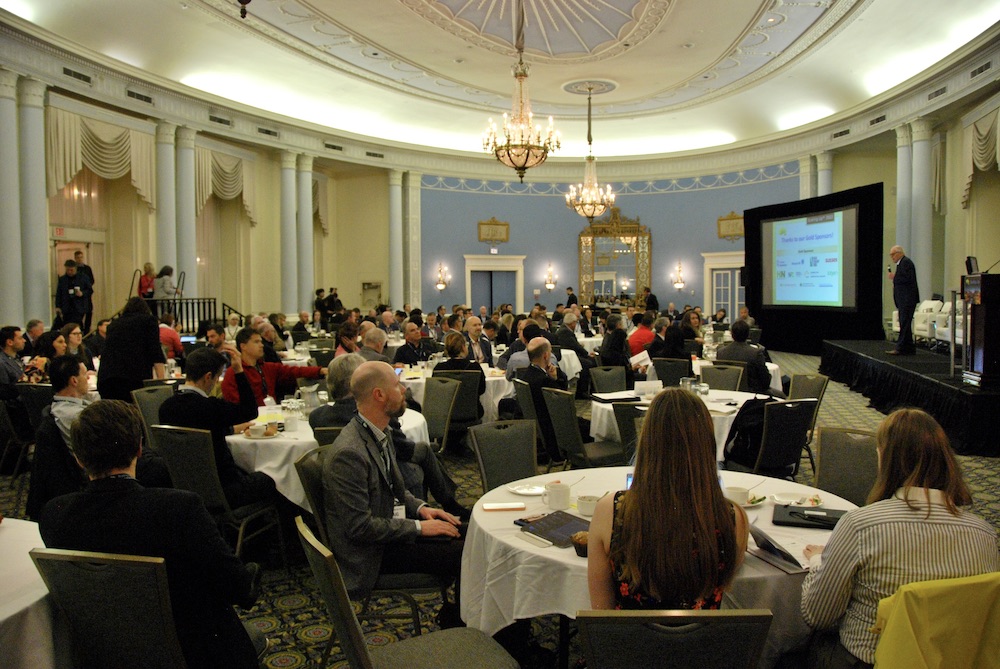 Jeff Passmore welcomes attendees of the 2023 Scaling Up conference in Ottawa last week. Photo: Annex Business Media.
Jeff Passmore welcomes attendees of the 2023 Scaling Up conference in Ottawa last week. Photo: Annex Business Media. The global bioeconomy is rapidly progressing and while Canada has seen some bright advancements, there are glaring gaps to fill if we want to be among the front runners.
Scaling Up, an annual bioeconomy conference in Ottawa last week, convened dozens of experts and many of them expressed the above sentiment, urging Canada to do more to bring about biobased products, fuels, and climate solutions.
Organizer Jeff Passmore with Passmore Group welcomed attendees and offered comments throughout the conference, often pointing to Canada’s “missing” national bioeconomy strategy. While representatives from Agriculture and Agri-Food Canada, Natural Resources Canada, and the Canadian Standards Association hinted at ongoing and collaborative work to advance the country’s bioeconomy, no announcement was made about a formal national strategy.
Jim Lane, editor and publisher of the U.S.-based Daily Digest, was among the opening keynotes and told the audience he’s in Canada with a specific message: the world needs feedstocks. The global bioeconomy has policy and economic tailwinds unlike ever before, with unprecedented emerging players, Lane said, but the bottleneck is a lack of feedstock to meet demand. “There is no country that gets the forest more, that gets feedstock more, than Canada,” he said.
Jamie Stephen with Torchlight Bioresources echoed Lane’s point with an urgent undertone. Canada’s forests – its largest feedstock opportunity – are going up in smoke. This year’s wildfires made that point clearer than ever.
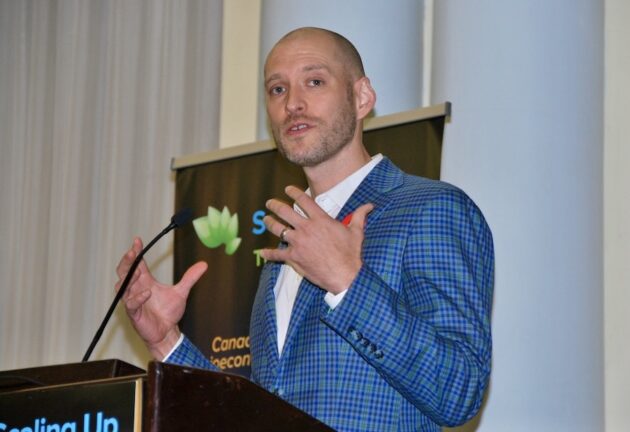
Jamie Stephen, Torchlight Bioresources. Photo: Annex Business Media.
“We are not a climate leader,” Stephen said. Canada total emissions, which must factor in emissions from wildfires, are equal to 83 per cent of the total EU emissions. Crown forests are a public resource, he said, and unless we manage those forests, which are increasingly subject to pests and wildfire, they will continue as a carbon source rather than a carbon sink.
Bioheat from forest residues, the leftover material from logging for wood products, represents the most significant and immediate impact Canada can have to lower its emissions, Stephen said. Bioenergy with carbon capture and storage would allow for a carbon negative option.
“It’s not sexy, it’s not some new pathway, but it is the most important thing we can do is create dispatchable heat,” he said. “Climate is a volume game – we can’t be ideological.”
First Nations spotlight
Dispatchable power from the forest is a familiar call to action for some First Nations communities in Canada that have been working to that end, in some cases, for decades.
Whitesand First Nation, an Ojibwa First Nation in Northwestern Ontario, has been working to sustainably eliminate the use of diesel generators for power since the early 1990s. We’ve shared updates on Whitesand’s saga over the years, and David Mackett is a familiar name to those who’ve been following it as well. Mackett championed the switch to biomass in the community for a good chunk of those years, and took to the Scaling Up stage to share the latest project developments.
Good news: the community is in the final stages of financing its 6.5MW biomass co-generation facility that will connect to the local micro-grid currently powered by a diesel generator. The co-gen facility is part of Whitesand’s Sagatay Co-Generation Limited Partnership, which is also planning to build a wood pellet plant and wood merchandising yard.
“Why should a First Nation not have access to develop and create power from their own forests?” Mackett asked the audience. “Biomass carbon reduction in Indigenous communities can lead to poverty reduction.”
Lake Nipigon Forest Management, a company comprising four First Nations in Northern Ontario, is on a similar journey to decarbonize using their forests, and things are ramping up fast. The forestry co-op is working with CharTech Solutions (formerly CHAR Technologies) to develop, build, own and operate a wood residues to renewable natural gas (RNG) and biochar facility. The project is hoping to break ground in September next year.
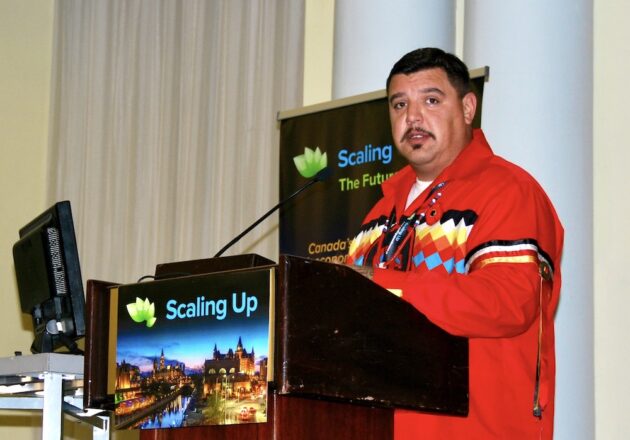
Chief Marcus Hardy, Red Rock Indian Band. Photo: Annex Business Media.
Chief Marcus Hardy of the Red Rock Indian Band and Jordan Hatton, director of economic development for the Bingwi Neyaashi Anishinaabek, both shared their perspectives representing of two of the four First Nations in the co-op.
For Chief Hardy, the impetus to explore a local energy project began with a close look at his energy bill. The delivery cost for power was higher than the cost of the power, despite that energy coming from generating plants in the Lake Nipigon area, he said. “It was my mission to find a way to heat our houses – out of poverty – so an elder doesn’t need to decide to pay the power bill or pay for groceries,” Chief Hardy said.
In addition to the biochar project, Bingwi Neyaashi Anishinaabek is at various stages with other forestry and biomass initiatives, including a fully operating sawmill, chipping operation, harvesting operation and plans for a biomass district heating system for their new build community. “It’s grown tremendously,” Hatton said of their forestry activity. “Now we’re actually earning revenue from the forest.”
SAF updates
Sustainable aviation fuel – or SAF – continues to create buzz in a room and several Scaling Up speakers offered updates in that space.
Madison Carroll, executive director of the Council on Sustainable Aviation Fuels Accountability (CoSAFA), introduced the organization and shared an overview of global and North American SAF markets and supply. Estimates put global SAF demand by 2050 at 5.8 per cent of jet fuel to meet current country targets – equating to 66.2 billion litres, Carroll said. Supply based on commercial off-take commitments is expected to be far below that number for 2050. Policy support, she said, is vital to encourage companies to build expensive SAF facilities and secure long-term offtake agreements.
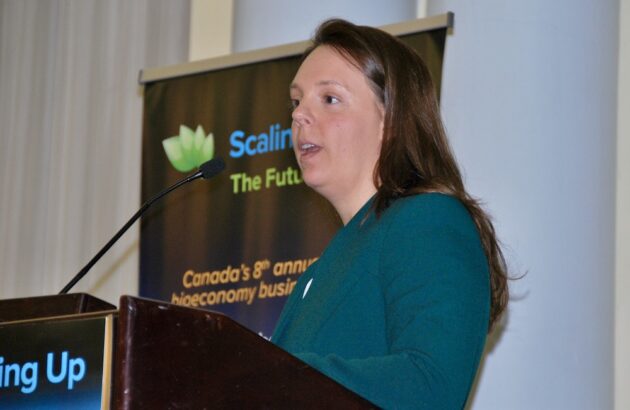
Madison Carroll, executive director of the Council on Sustainable Aviation Fuels Accountability (CoSAFA). Photo: Annex Business Media.
Industry-led CoSAFA is creating methodology to offer a clear understanding and rules around SAF transactions, which will factor in the “second benefit” of SAF, its environmental attributes, Carroll said. The methodology will give clear, consistent and comparable environmental information throughout the SAF chain of custody, interoperable with various compliance requirements and individual systems or registries.
“You need a clear understanding and clear rules for how you can value that environmental attribute,” Carroll said.
Chairing a panel session on SAF international regulatory battles, Fred Ghatala with Advanced Biofuels Canada noted there has never been a more enthusiastic and committed end-use sector than commercial aviation. Canada has set an aspiration gaol of 10 per cent SAF by 2030.
Boeing Canada’s Pierre Ruel shared an analysis from Air Transportation Action Group’s Waypoint 2050 report that found with existing technology limitations, long-haul commercial aviation specifically will need to deploy SAF up to 2050. Boeing has developed a public web tool called Boeing Cascade Climate Impact Model that visualizes and evaluates pathways to decarbonize aviation.
Geoff Tauvette, executive director of the Canadian Council for Sustainable Aviation Fuels (C-SAF), says they’re no longer calling aviation a “hard to abate” sector. “We know how to decarbonize it – it’s SAF,” Tauvette said.
C-SAF, a consortium of 60 airlines operating in Canada, released its SAF Roadmap in June this year, which details its policy framework and priority areas to decarbonize aviation while remaining competitive. “We want to avoid a patchwork of policies that pop up here and there,” Tauvette said in reference to the roadmap.
Projects to watch
A couple new Canadian players took to the Scaling Up stage that we will be keeping an eye on.
Hydrogenii Canada CEO Martin Vroegh introduced the company’s technology that can produce hydrogen from hydrogen sulfide, a by-product of several industries including cement production and oil and gas. The technology can also be used as part of the anaerobic digester process, which Vroegh says affords them access to the pipelines where hydrogen can be injected into the natural gas grid.
The company is awaiting funding from financing agreements and expects to have a mobile demonstration pilot in the next six to 10 months.
Calgary-based SixRing has been making headlines for a couple years and chief technology officer Markus Weissenberger said they’re expecting to have an operational pilot plant in Lethbridge, Alta., by the end of next year. The company’s feedstock-agnostic delignification process creates liquid lignin-hemicellulose-depolymerized-organics and solid cellulose from non-food biomass.
Weissenberger noted their products represent two pathways to SAF: cellulosic ethanol, an established pathway, and light crude blend, which would be a new SAF pathway.
Awarded player
For the second year in a row, Passmore honoured a speaker with the Scaling Up Award to mark their contributions to Canada’s bioeconomy growth. This year’s award went to Jordon Solomon, president and CEO of Ecostrat. Ecostrat is the pioneering company behind the Bioeconomy Development Opportunity Zone Initiative, which is helping de-risk biomass supply chains by rating and identifying biomass-rich regions and connecting them with international biomass developers and investors.
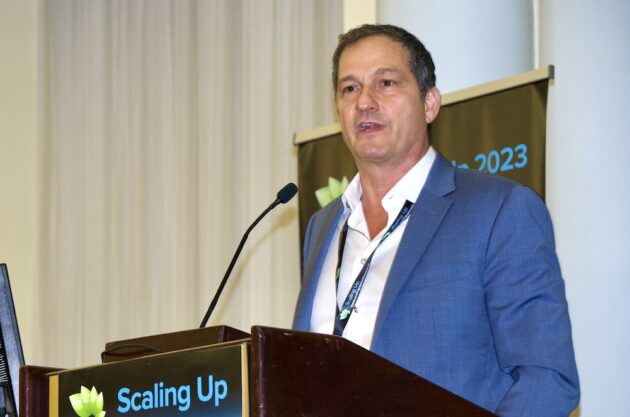
Jordon Solomon, president and CEO of Ecostrat. Photo: Annex Business Media.
Print this page